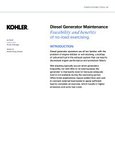As our world becomes more and more technologically interwoven, the importance of a robust disaster recovery plan for data centers is crucial. With data centers serving as the nucleus of many organizations, downtime due to unforeseen circumstances such as natural disasters or cyber attacks, can be detrimental.
A well thought out disaster recovery plan that leans on backup power to safeguard against data loss and downtime is instrumental in enabling a data center to regain its technology and operations as soon as possible after a major failure strikes.
It’s not just a matter of filling in cracks and gaps that can emerge over time: it’s a matter of understanding that the future of disaster recovery for data centers is now, planning is forthwith and the incorporation of backup power systems into the plan is critical.
The need and growth of disaster recovery plans for businesses
Risks and threats of different shapes and sizes are growing, and the ability to avoid disaster is increasingly beyond the control of business leaders. For data centers, though, the increased danger simply means a heightened emphasis on disaster recovery preparation.
Technological advancements are known contributing factors, while natural disasters are becoming more common, and less predictable.
The number of disasters reported have increased five-fold over the past five decades, and 10-fold over the past 100 years, with storms like hurricanes and blizzards constituting 30 percent of all natural disasters – a pertinent threat for all data centers.
When failure inevitably hits, those that just started thinking about how to respond to the crisis are too late. As the ability to avoid failures becomes less and less realistic, preventative measures become more and more important.
Pressure on data centers during times of crisis
The general need for functional IT in the event of a disaster is growing, placing extra pressure on data centers. Data centers have a self-interest in ensuring their own resiliency, but they also have a responsibility to serve their communities with vital services when they’re needed most.
During the period between 2000 and 2019, the United Nations recorded over 7,000 significant natural disasters that claimed over a million lives.
In the days of social media and mobile apps, data centers can serve the civilians directly affected by the disaster. During the 9/11 attacks of 2001, only around five percent of information about the event was delivered by mobile phone, computer, or tablet. By the Boston Marathon bombing 11 years later, however, that number jumped to 30 percent. In the present day, that number is dramatically higher still.
Data centers can provide support in much larger ways, too. Significant natural disaster situations require considerable collaboration between many government and non-government agencies and organizations to provide relief and support.
When disaster relief teams improve their capacity for things like temporary housing or emergency transportation, an increased capacity for communications and IT systems comes hand-in-hand.
As data centers secure backup power supplies to ensure their operations can continue even in the midst of disaster, they will play a larger and larger role in the recovery efforts of the communities they serve.
Growth in risks of power loss during disasters
Recently, residents in places like California and Texas have been called on to cut back their power usage in the face of blackout fears. Additionally, weather-related power outages have doubled over the last 20 years, with outages becoming more widespread and lasting longer.
The trend toward electrifying more everyday processes such as car fueling and home heating means the demand for power system functions to perform is going up, and many grids are not prepared to handle the added stress.
In light of an increasingly vulnerable access to electricity, backup power represents a central need requiring special attention for data centers. Part of that importance derives from electricity’s crucial, core role in day-to-day business and social functions.
Another part of the reason to focus on electricity is because resiliency efforts can be so effective. By concentrating efforts on power resiliency planning, one study showed that an individual business can reduce the operational effect of a power outage by as much as 86 percent.
Utilizing backup power in your disaster recovery plan
With the goal of creating a formal document for all to follow in times of crisis, creating a comprehensive disaster recovery plan is extensive and it can be tempting for data center leaders to deprioritize a topic like backup generators on the back burner – a dire error that can be avoided by prioritizing a process-based mindset.
While the idea that when it comes to disaster recovery plan creation, not all assessments are the same, regardless of analysis style, all plans lead back to the importance of backup power.
One example is business impact analysis (BIA). In BIA, organizations take inventory of all assets and services, then examine the impact different types of incidents would bring to each. This examination includes both financial costs and non-financial losses like reputation, safety, legal compliance, or regulatory penalties.
Often, BIA discussions center around how long a certain service or asset can be down before losses occur. From the perspective of backup power, this type of DR evaluation shows just how pervasive the need for backup power truly is.
As data center organizations pore over their assets – hardware, software, networks, virtual machines, security services, SaaS services, and more – each individual asset requires electricity to function. So, regardless of the final result of the BIA process, backup power will be a top priority for each and every asset regardless of risk or loss evaluation.
Disaster recovery planning for data centers is not just a precautionary measure, but an essential strategy in today’s technologically driven world. The integration of backup power into the plan is a crucial element, serving as a trusted backbone during unforeseen events and circumstances.
More from Kohler Power
-

Diesel generator maintenance
Explore the feasibility and benefits of no-load exercising
-

Delivering more sustainable mission-critical generators - now and in the future
Explore more sustainable mission-critical power technologies
-

Sponsored Southeast Asia’s growing data center market embraces sustainability
Advances in generator and battery technologies are contributing significant reductions in emissions, but neither fuel cells nor batteries can yet match diesel for convenience and energy density


